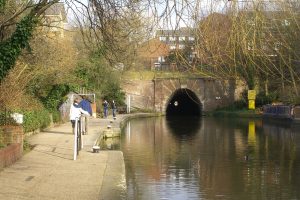As you meander along the pathways that trace the course of Regent’s Canal, the waterway feels like a tranquil pause amid the bustling life of London. These days, it offers a serene environment for canal boat trips, walks along the towpath, and perhaps even a lunchtime sojourn near Granary Square. Yet, it’s essential to remember that this picturesque canal is not just a leisure facility; it’s a vibrant part of London’s industrial history, intrinsically tied to the ebb and flow of the city’s growth.
Regent’s Canal: More Than Just Scenery

The Regent’s Canal you experience today, complete with scenic boats and towpaths, is a far cry from its original purpose. Established in 1820, the canal was designed to facilitate the transportation of goods into London’s heart during the burgeoning years of the Industrial Revolution. What began as the ambitious vision of Thomas Homer—of connecting the Grand Junction Canal at Paddington to the Limehouse Docks—did face initial challenges. From landowner objections to a scandalous embezzlement of funds by Homer himself, the project weathered numerous setbacks before finally coming to fruition.
The Grand Opening and Royal Patronage
James Nash, an architect and a close confidant of the Prince Regent, later King George IV, played a significant role in both the completion of the canal and its naming. Nash, along with other directors, inaugurated the canal by travelling its full length in a ceremonial barge. It was his influence that secured the royal imprimatur for the canal, a nod to his friendship with the Prince Regent.
The Industrial Vein of 19th-Century London
In its prime, Regent’s Canal was the epitome of efficiency. A horse could transport thirty times more weight on water than overland, making the canal an indispensable conduit for raw materials from around the globe. Coal and timber were the primary commodities, but the canal also carried metals like iron, brass, and copper. Warehouses and depots sprung up along its banks, and it even facilitated gas production for street lighting and homes in Kings Cross. Fresh produce, including ice stored at Battlebridge Basin—now the Canal Museum—was also a frequent cargo.
Engineering Marvels: Locks and Tunnels
Twelve locks dot the stretch of Regent’s Canal to manage the descent towards the River Thames. These locks, some of which can be seen at Kings Cross, required lock keepers to work twelve-hour shifts when the canal was in full operation. The route also boasts three tunnels, the longest being the Islington tunnel at an impressive 880 metres. The unique challenge of moving barges through these tunnels was initially met by the back-breaking work of ‘legging’ until steam tugs eventually took over.
From Industrial Workhorse to Leisurely Lane
By the 1940s, commercial transport on the canal began to diminish, and by the late ’60s, lorries had largely supplanted it. Today, the canal serves as a testament to the complex layers of London’s industrial past, even as it has evolved to offer the public a leisurely experience imbued with historical resonance.
Discover More with the ‘All Change at Kings Cross Walk’
If you’re keen to delve deeper into the intricate tapestry of London’s industrial history, join us on our ‘All Change at Kings Cross Walk.’ The walk promises an enlightening journey through time, providing an immersive experience that celebrates both the old and the new.
We invite you to explore these compelling stories that contribute to the rich, evolving narrative of London, a city whose past and present are intricately woven along its iconic waterways.
Book our All Change at Kings Cross Walk and find out more about London’s industrial past.





